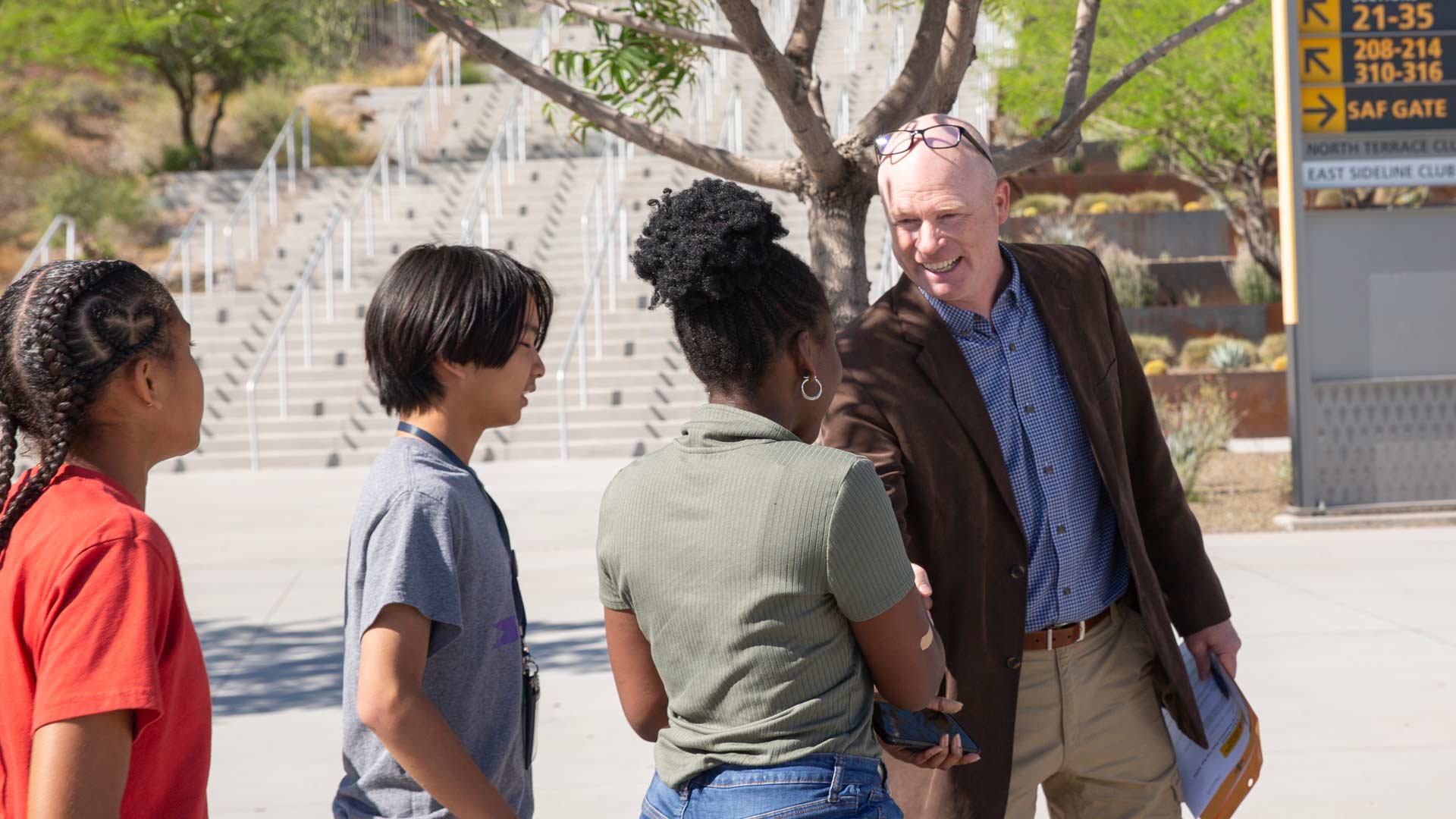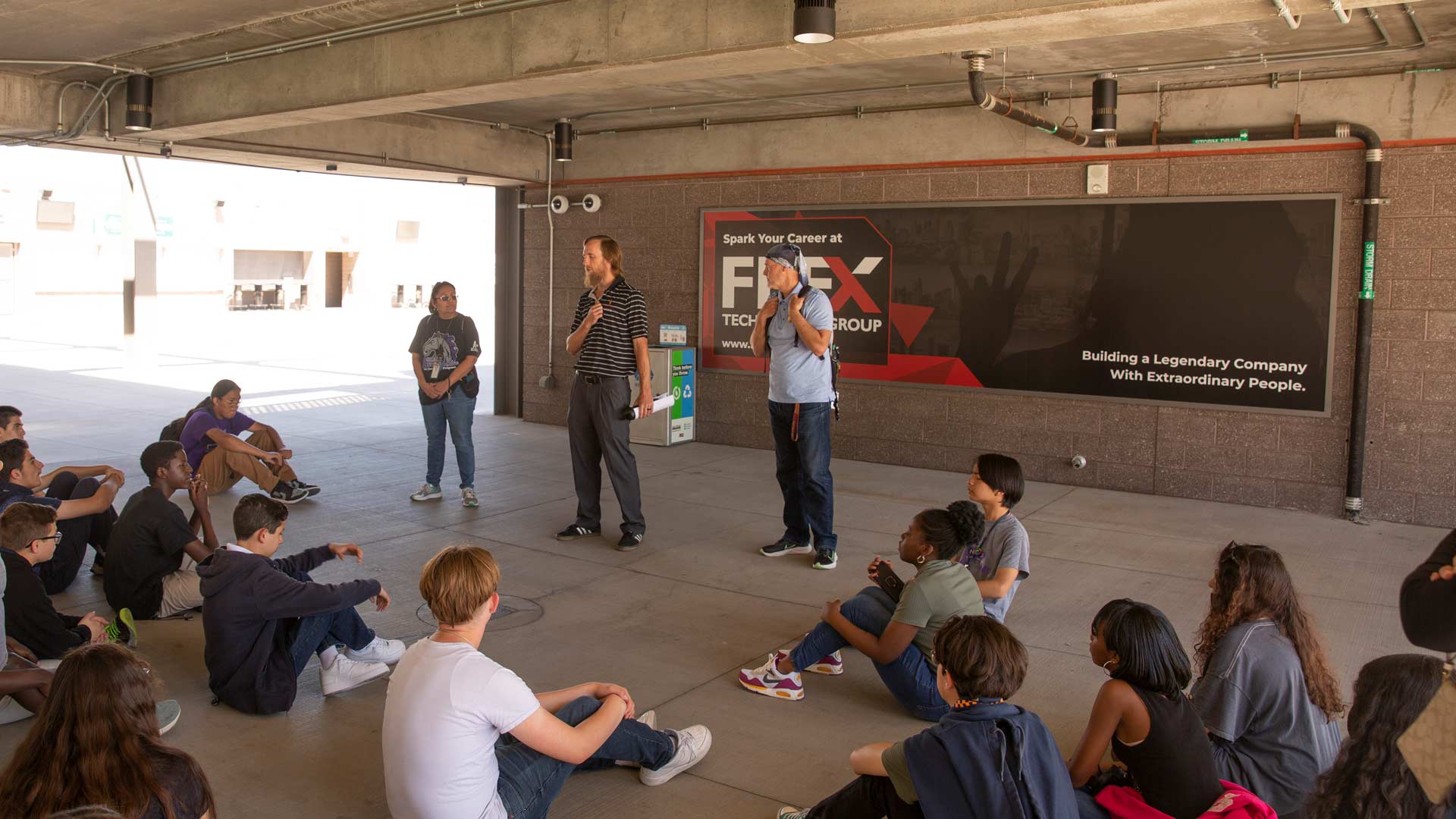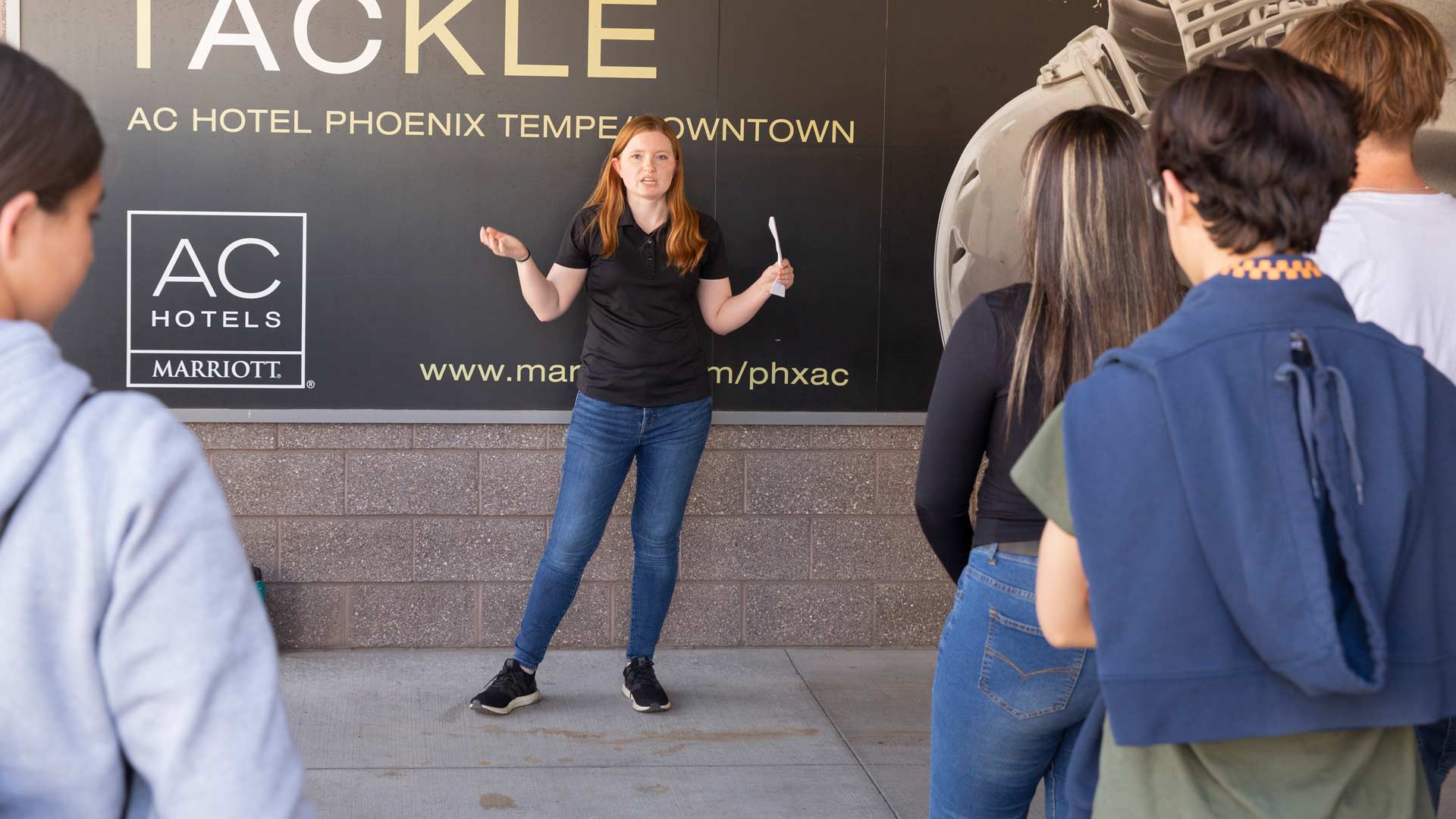There's something electric about more than 50,000 football fans descending upon Sun Devil Stadium on Arizona State University’s Tempe campus during a fall weekend to watch their home team play.
And nearly every facet of any gamegoer’s experience involves engineering.
Fans need to use transportation to get to get to the stadium. The stadium itself was designed and built by architects and engineers. Utility companies provide essential services to keep the stadium running — such as water, power and sanitation.
Engineering is everywhere, and many diverse fields of engineering are necessary to provide a seamless experience for fans.
This is the message that Gregory Haggerty, CEO of Dibble, a full-service engineering company, conveyed to a group of 120 seventh- and eighth-grade students from the Laveen School District during a visit to the stadium.
Dibble CEO Greg Haggerty shakes hands with students from the Laveen School District at the start of a tour of Sun Devil Stadium. Photo by Erik Wirtanen/ASU
During the tour, which was hosted by Dibble and engineers in the Ira A. Fulton Schools of Engineering, students learned through the lens of professionals.
Haggerty’s goal in organizing the tour was to give students a lifelong memory and experience that may one day influence their academic and career choices.
Dibble is a member of the Friends of Civil and Environmental Engineering, also known as FOCE2, an industry advisory group in the School of Sustainable Engineering and the Built Environment, part of the Fulton Schools, that champions workforce development initiatives.
“I hope they will someday attend a university like ASU, become a professional engineer and serve millions of people through their work planning, designing and building the infrastructure that allows great events to occur,” Haggerty said. “A stadium provides an exciting environment, but game day cannot happen without engineers preparing a built environment that supports the gathering of 55,000 attendees.”
Students on the tour rotated through four locations in and surrounding the stadium, where volunteers highlighted the various aspects of engineering.
“It is entirely appropriate for students to understand how public safety is served by engineered water, energy, transportation, structural and communication systems,” Haggerty said. “Each of these systems has a profound impact on every facet of modern life and they require great investments of time, talent and treasure to keep them in good working order.”
Travis Dunn (standing, middle), a Fulton Schools alumnus and current senior project engineer at Dibble, and Bob Hansman, Jr. (standing, far right) answered questions from Laveen School District students about engineering at Sun Devil Stadium. Photo by Erik Wirtanen/ASU
Engineering on display
At one stop on the tour, a volunteer highlighted the airplanes overhead landing at Sky Harbor International Airport and the cars driving along the 202 freeway and Rio Salado Parkway. He pointed out how each of those methods of transportation operates as smoothly as they do because of engineers.
The students also learned about the concrete used to build the stadium structure itself, observing the columns that support the substantial weight of the upper sections. They gained an understanding of the inner workings of the stadium by viewing the pipes and wires running through the structure that provide everything from water and electricity to internet service.
It was a warm morning, so students were often eager to seek shelter from the sun under a concrete overhang. One of the tour volunteers pointed out that the students had stood under the structure without a second thought, taking for granted the amount of structural engineering and careful calculation that went into its construction.
The tour highlighted just how broadly engineering reaches.
“The students were able to walk around and see things that we never think about in terms of how they are getting built. It just exists,” said Christina Pineda, an eighth-grade teacher at Rogers Ranch Elementary. “They were surprised to learn that even the landscape and surrounding area is shaped by engineering.”
Tour volunteers explained that it’s sometimes hard to comprehend how vast engineering’s impact can be.
“Several students were excited to learn about how everything is planned out, that even as an engineer they don’t have to be an expert on everything,” Pineda said.
Kelly Hyde, one of the tour volunteers who works for Henderson Engineers, explained that electrical engineers can work in many different areas, from power plants that create the electricity used to power the stadium to creating the scoreboard inside the stadium.
Another volunteer, Victoria Flys, is a structural engineer at Meyer Borgman Johnson and a Fulton Schools alumna. Pineda sayid the girls in her class were happy to learn from Flys’ example that women can be successful engineers.
Victoria Flys, a Fulton Schools alumna and structural engineer at Meyer Borgman Johnson, explained to students from the Laveen School District how structural engineering and concrete work went into the building of Sun Devil Stadium. Photo by Erik Wirtanen/ASU
Inspiring interest in STEM
The tour was a result of the shared interests of the American Council of Engineering Companies of Arizona, or ACEC, and the Laveen School District in exposing students to engineering before they enter ninth grade, said tour organizer Haggerty, who is chair-elect of the council.
“Achieving positive results in math and science in high school prepares students for engineering curriculum as an incoming college freshman,” Haggerty said. “Missing out on that kind of education in their early years can become a limiting factor for students. We want to make kids aware of the opportunities that come with abilities in math and science.”
Joe Roselle, the community engagement coordinator at Laveen Elementary School District, echoed Haggerty’s sentiments and emphasized the importance of STEM education at Rogers Ranch Elementary, a STEM-focused school, and Desert Meadows Elementary, a computer science-focused school.
“Both schools have realized that if we want to close the STEM employment gap, we need to engage all students in quality STEM instruction and experiences,” Roselle said. “Part of this process is going on meaningful STEM profession field trips.”
Haggerty said ACEC Arizona’s Education Committee already has ideas to scale up the Sun Devil Stadium infrastructure tour to engage larger numbers of students.
The education committee wants to introduce engineering to families throughout Arizona using signature facilities like Sun Devil Stadium to connect industry with school classrooms.
“The next tour will involve 1,200 students at Sun Devil Stadium, and it will include a request for a 400-student tour at NAU and 400 more students at UA,” Haggerty said. “Beyond that, a vision for introducing 12,000 students annually to engineering through these signature stadium tours inspires all of us.”
Top photo: Laveen School District students toured Sun Devil Stadium as they learned about how people in engineering and other STEM careers help make game day at the stadium possible. Photo by Erik Wirtanen/ASU
More Science and technology

Hack like you 'meme' it
What do pepperoni pizza, cat memes and an online dojo have in common?It turns out, these are all essential elements of a great cybersecurity hacking competition.And experts at Arizona State…

ASU professor breeds new tomato variety, the 'Desert Dew'
In an era defined by climate volatility and resource scarcity, researchers are developing crops that can survive — and thrive — under pressure.One such innovation is the newly released tomato variety…

Science meets play: ASU researcher makes developmental science hands-on for families
On a Friday morning at the Edna Vihel Arts Center in Tempe, toddlers dip paint brushes into bright colors, decorating paper fish. Nearby, children chase bubbles and move to music, while…





